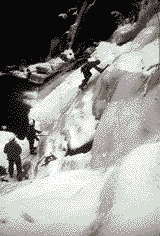 One
doesn't usually think of New Jersey's Kittatinny Mountains in the same
breath as glaciers and icy slopes of higher mountains. Some years this
changes in January and February when ice climbing routes come "into condition" on
Mount Tammany and on many waterfalls in the Delaware Water Gap National
Recreation Area.
One
doesn't usually think of New Jersey's Kittatinny Mountains in the same
breath as glaciers and icy slopes of higher mountains. Some years this
changes in January and February when ice climbing routes come "into condition" on
Mount Tammany and on many waterfalls in the Delaware Water Gap National
Recreation Area.
A dozen climbers may hover on an ice curtain alongside Buttermilk Falls, Slateford Falls, and several other small hollows hidden along the ridges. The vertical drop may be a short 10-50 feet, but this provides the training grounds for those dreaming of higher mountains and thinner air. When the temperature falls to zero, the layers of clothes and gloves detract from natural and easy mobility, but the precision needed to place the thin metal spikes (called crampons) that adorn the climber's feet is the same whether you are 10 or 1000 feet up on an ice cliff.
Some years when the days warm up to near freezing, and the nights remain far colder, a ribbon of ice forms on Mount Tammany. Starting out over talus blocks and following the ice route upward all day can transport your imagination to the most remote regions on earth, or at the very least, convince you to take up hiking.
Winter waterfalls are attractive even if you aren't looking for a sport to take your breath away. Although winter hiking is much less risky, it requires more preparation than a summer ramble. You need to carry water in a thermos or next to your body so it doesn't freeze. Extra socks, gloves, and sweater should be in your pack in case you lose one or the one you're wearing gets wet. And make sure you plan a much shorter route than you would during warmer weather.